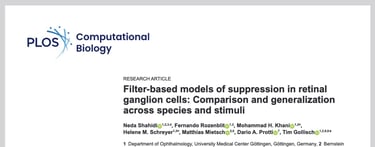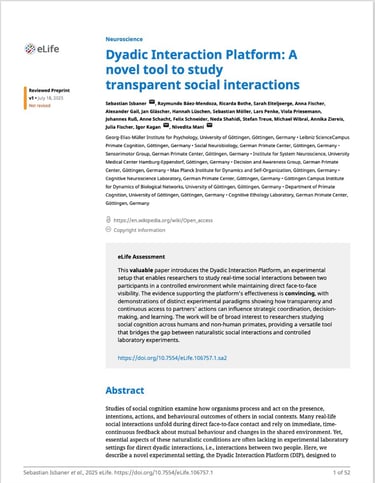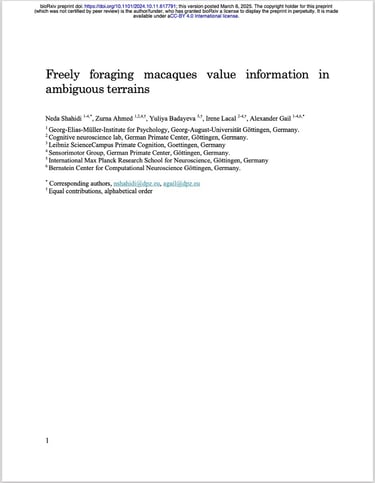Abstracts
Dyadic Interaction Platform: A novel tool to study transparent social interactions
Studies of social cognition examine how organisms process and act on the presence, intentions, actions, and behavioural outcomes of others in social contexts. Many real-life social interactions unfold during direct face-to-face contact and rely on immediate, time-continuous feedback about mutual behaviour and changes in the shared environment. Yet, essential aspects of these naturalistic conditions are often lacking in experimental laboratory settings for direct dyadic interactions, i.e., interactions between two people. Here, we describe a novel experimental setting, the Dyadic Interaction Platform (DIP), designed to investigate the behavioural and neural mechanisms of real-time social interactions. Based on a transparent, touch-sensitive, bi-directional visual display, this design allows two participants to observe visual stimuli and each other simultaneously, allowing face-to-face interaction in a shared vertical workspace. Different implementations of the DIP facilitate interactions between two human adults, adults and children, two children, nonhuman primates and in mixed nonhuman-human dyads. The platforms allow for diverse manipulations of interactive contexts and synchronized recordings of both participants’ behavioural, physiological, and neural measures. This approach enables us to integrate economic game theory with time-continuous sensorimotor and perceptual decision-making, social signalling and learning, in an intuitive and socially salient setting that affords precise control over stimuli, task timing, and behavioural responses. We demonstrate the applications and advantages of DIPs in several classes of transparent interactions, ranging from value-based strategic coordination games and dyadic foraging to social cue integration, information seeking, and social learning.
Freely foraging macaques value information in ambiguous terrains
Among non-human primates, macaques are recognized for thriving in a wide range of novel environments. Previous studies show macaque’s affinity for new information. However, little is known about how information-seeking manifests in their spatial navigation pattern in ambiguous foraging terrains, where the location and distribution of the food are unknown. We investigated the spatial pattern of foraging in free-moving macaques in an ambiguous terrain, lacking sensory cues about the reward distribution. Rewards were hidden in a uniform grid of woodchip piles spread over a 15 sqm open terrain and spatially distributed according to different patchy distributions. We observed Lévy-like random walks in macaques’ spatial search pattern, balancing relocation effort with exploration. Encountering rewards altered the foraging path to favor the vicinity of discovered rewards temporarily, without preventing longer-distance travels. These results point toward continuous exploration, suggesting that explicit information-seeking is a part of macaques’ foraging strategy. We further quantified the role of information seeking using a kernel-based model, combining a map of ambiguity, promoting information seeking, with a map of discovered rewards and a map of proximity. Fitting this model to the foraging paths of our macaques revealed individual differences in their relative preference for information, reward, or proximity. The model predicted that a balanced contribution of all three factors performs and adapts to an ambiguous terrain with semi-scattered rewards, a prediction we confirmed using further experimental evidence. We postulate an explicit role for seeking information as a valuable entity to reduce ambiguity in macaques’ foraging strategies, suggesting an ecologically valid way of foraging ambiguous terrains.
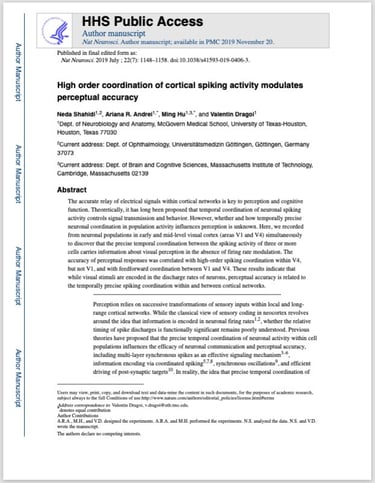

High order coordination of cortical spiking activity modulates perceptual accuracy
The accurate relay of electrical signals within cortical networks is key to perception and cognitive function. Theoretically, it has long been proposed that temporal coordination of neuronal spiking activity controls signal transmission and behavior. However, whether and how temporally precise neuronal coordination in population activity influences perception is unknown. Here, we recorded from neuronal populations in early and mid-level visual cortex (areas V1 and V4) simultaneously to discover that the precise temporal coordination between the spiking activity of three or more cells carries information about visual perception in the absence of firing rate modulation. The accuracy of perceptual responses was correlated with high-order spiking coordination within V4, but not V1, and with feedforward coordination between V1 and V4. These results indicate that while visual stimuli are encoded in the discharge rates of neurons, perceptual accuracy is related to the temporally precise spiking coordination within and between cortical networks.
Dynamic states of population activity in prefrontal cortical networks of freely-moving macaque
Neural responses in the cerebral cortex change dramatically between the ‘synchronized’ state during sleep and ‘desynchronized’ state during wakefulness. Our understanding of cortical state emerges largely from experiments performed in sensory areas of head-fixed or tethered rodents due to technical limitations of recording from larger freely-moving animals for several hours. Here, we report a system integrating wireless electrophysiology, wireless eye tracking, and real-time video analysis to examine the dynamics of population activity in a high-level, executive area – dorsolateral prefrontal cortex (dlPFC) of unrestrained monkey. This tech- nology allows us to identify cortical substates during quiet and active wakefulness, and transitions in population activity during rest. We further show that narrow-spiking neurons exhibit stronger synchronized fluctuations in population activity than broad-spiking neurons regardless of state. Our results show that cortical state is controlled by behavioral demands and arousal by asymmetrically modulating the slow response fluctuations of local excitatory and inhibitory cell populations.
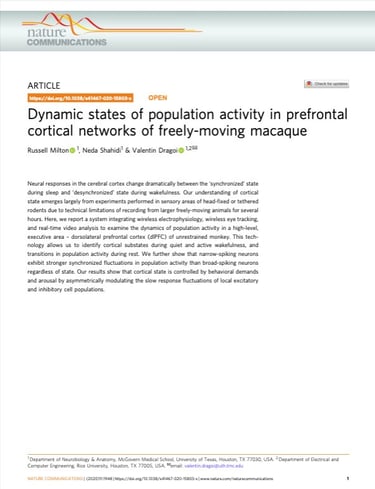

Population coding of strategic variables during foraging in freely moving macaques
Until now, it has been difficult to examine the neural bases of foraging in naturalistic environments because previous approaches have relied on restrained animals performing trial-based foraging tasks. Here we allowed unrestrained monkeys to freely interact with concurrent reward options while we wirelessly recorded population activity in the dorsolateral prefrontal cortex. The animals decided when and where to forage based on whether their prediction of reward was fulfilled or violated. This prediction was not solely based on a history of reward delivery, but also
on the understanding that waiting longer improves the chance of reward. The task variables were continuously represented in a subspace of the high-dimensional population activity, and this compressed representation predicted the animal’s subsequent choices better than the true task variables and as well as the raw neural activity. Our results indicate that monkeys’ foraging strategies are based on a cortical model of reward dynamics as animals freely explore their environment.
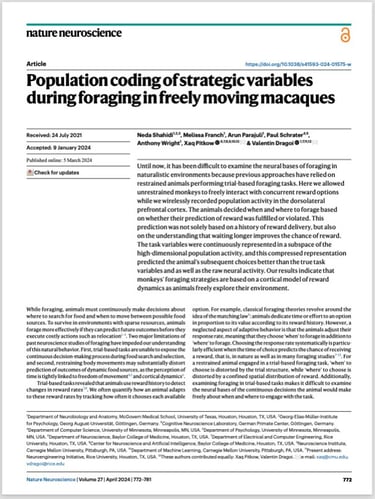

Filter-based models of suppression in retinal ganglion cells: Comparison and generalization across species and stimuli
The dichotomy of excitation and suppression is one of the canonical mechanisms explaining the complexity of neural activity. Computational models of the interplay of excitation and suppression in single neurons aim at investigating how this interaction affects a neuron’s spiking responses and shapes the encoding of sensory stimuli.
Here, we compare the performance of three filter-based stimulus-encoding models for predicting retinal ganglion cell responses recorded from axolotl, mouse, and marmoset retina to different types of temporally varying visual stimuli. Suppression in these models is implemented via subtractive or divisive interactions of stimulus filters or by a response-driven feedback module. For the majority of ganglion cells, the subtractive and divisive models perform similarly and outperform the feedback model as well as a linear-nonlinear (LN) model with no suppression. Comparison between the subtractive and the divisive model depends on cell type, species, and stimulus components, with the divisive model generalizing best across temporal stimulus frequencies and visual contrast and the subtractive model capturing in particular responses for slow temporal stimulus dynamics and for slow axolotl cells. Overall, we conclude that the divisive and subtractive models are well suited for capturing interactions of excitation and suppression in ganglion cells and perform best for different tempora lregimes of these interactions.

